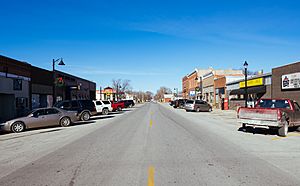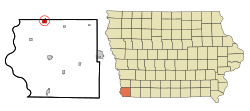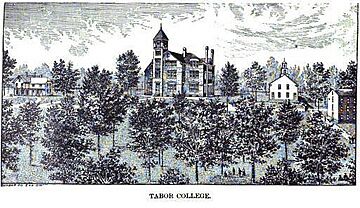Tabor, Iowa facts for kids
Quick facts for kids
Tabor
|
|
|---|---|
 |
|

Location of Tabor, Iowa
|
|
| Country | |
| State | |
| Counties | Fremont, Mills |
| Area | |
| • Total | 1.29 sq mi (3.35 km2) |
| • Land | 1.29 sq mi (3.35 km2) |
| • Water | 0.00 sq mi (0.00 km2) |
| Elevation | 1,240 ft (380 m) |
| Population
(2020)
|
|
| • Total | 1,014 |
| • Density | 784.83/sq mi (303.08/km2) |
| Time zone | UTC-6 (Central (CST)) |
| • Summer (DST) | UTC-5 (CDT) |
| ZIP code |
51653
|
| Area code(s) | 712 |
| FIPS code | 19-76935 |
| GNIS feature ID | 468776 |
| Website | www.taboriowa.us |
Tabor is a small city located in the state of Iowa in the United States. It is mostly in Fremont County, but a small part reaches into Mills County. In 2020, about 1,014 people lived in Tabor.
Contents
Geography of Tabor
Tabor covers a total area of about 1.29 square miles (3.35 square kilometers). All of this area is land, meaning there are no large lakes or rivers within the city limits.
History of Tabor
Founding of Tabor and Tabor College
The city of Tabor was started in 1852 by families from Oberlin, Ohio. These families were mostly Congregationalists, a type of Christian group. They were very generous people who had moved from New England and Ohio. They believed strongly in freedom for all. Among the founders were Christian leaders like George Gaston, Samuel A. Adams, and Reverend John Todd.
They chose this location to build a Christian college. This college became known as Tabor College. The founders liked the high ground of the area. They named the town "Tabor" after Mount Tabor, a mountain in the Bible near Nazareth. Nazareth was the town where Jesus grew up.
Tabor's Role in the Abolitionist Movement
Tabor became a very important place for people who wanted to end slavery. These people were called abolitionists. Reverend Todd, one of the college founders, was a "conductor" on the Underground Railroad. The Underground Railroad was a secret network. It helped enslaved people escape to freedom in the North.
People in Tabor held special prayer meetings every month to support the anti-slavery cause. They often helped runaway slaves find safety.
Tabor During Bleeding Kansas
Between 1854 and 1860, there was a lot of fighting in Kansas. This time was called "Bleeding Kansas". It was about whether Kansas would become a free state or a slave state. Tabor was on a special path that allowed anti-slavery people to get to Kansas. This path helped them avoid going through Missouri, which was a slave state.
An important event happened in Tabor during this time. A shipment of 200 Sharps rifles was sent from Boston. These rifles were for people in Kansas who wanted it to be a free state. They were stored safely in John Todd's barn in Tabor.
Later, from 1857 to 1858, the famous abolitionist John Brown spent a winter in Tabor. He gathered and trained men there. These men were preparing for his famous raid on Harpers Ferry. This raid was an attempt to start a slave rebellion.
Tabor College and the Railway
Tabor College was in the city from 1853 until 1927. It closed because of money problems. During World War II, the college buildings were used to house German prisoners of war.
A small railway, called the Tabor & Northern Railway, also operated here. It was 9 miles long and connected Tabor to the Wabash Railroad in Malvern. The college itself ran this railway from 1889 to 1934.
Population Information
| Historical populations | ||
|---|---|---|
| Year | Pop. | ±% |
| 1870 | 310 | — |
| 1880 | 320 | +3.2% |
| 1890 | 503 | +57.2% |
| 1900 | 934 | +85.7% |
| 1910 | 909 | −2.7% |
| 1920 | 1,186 | +30.5% |
| 1930 | 1,017 | −14.2% |
| 1940 | 976 | −4.0% |
| 1950 | 869 | −11.0% |
| 1960 | 909 | +4.6% |
| 1970 | 957 | +5.3% |
| 1980 | 1,088 | +13.7% |
| 1990 | 994 | −8.6% |
| 2000 | 993 | −0.1% |
| 2010 | 1,040 | +4.7% |
| 2020 | 1,014 | −2.5% |
| Source: and Iowa Data Center Source: |
||
Tabor's Population in 2020
In 2020, the city of Tabor had 1,014 people living there. There were 386 households, which are groups of people living together. About 93.5% of the people were White. A small number were from other racial groups. About 2.3% of the population was Hispanic or Latino.
The average age in Tabor was 41.1 years old. About 29.3% of the people were under 20 years old. About 21.9% were 65 years or older. The city had slightly more females (52.4%) than males (47.6%).
Tabor's Population in 2010
In 2010, Tabor had 1,040 people. Most of the people (98.5%) were White. About 2% of the population was Hispanic or Latino.
The average age in 2010 was 44.3 years. About 23.2% of residents were under 18. About 22.2% were 65 or older. The population was 48.3% male and 51.7% female.
Education in Tabor
Public schools in Tabor are run by the Fremont–Mills Community School District.
Places to Visit and Historic Sites
Tabor has several important historic places:
- Todd House (built in 1853): This was the home of abolitionist John Todd. It was also a station on the Underground Railroad. Today, it is a museum.
- Hunter School (built in 1901): This is a historic one-room school house.
- Tabor Antislavery Historic District (established in 1853): This area includes several buildings and places connected to the anti-slavery movement.
See also
 In Spanish: Tabor (Iowa) para niños
In Spanish: Tabor (Iowa) para niños


